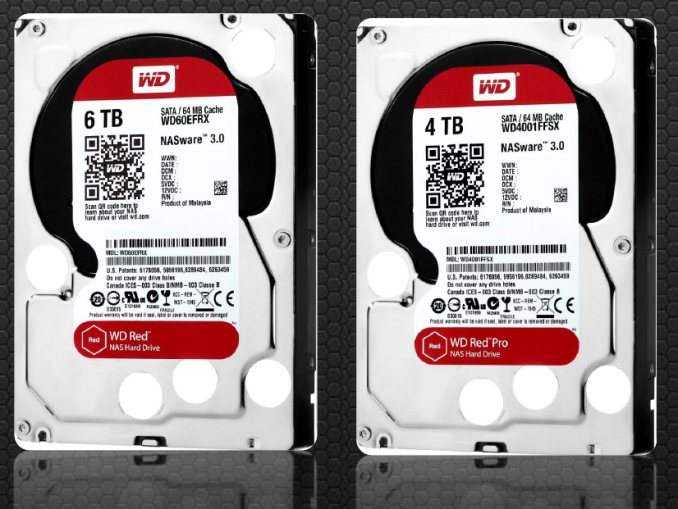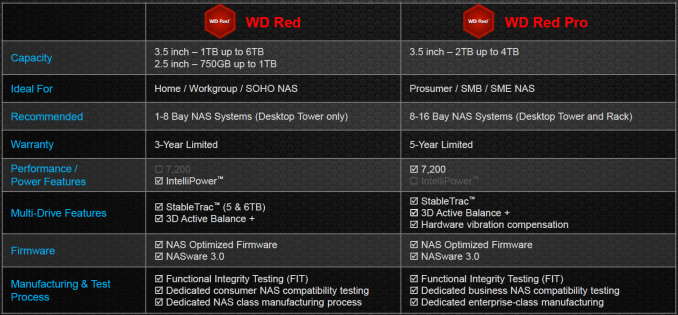Western Digital Updates Red NAS Drive Lineup with 6 TB and Pro Versions
by Ganesh T S on July 21, 2014 8:00 AM EST- Posted in
- NAS
- Storage
- Western Digital

Back in July 2012, Western Digital began the trend of hard drive manufacturers bringing out dedicated units for the burgeoning NAS market with the 3.5" Red hard drive lineup. They specifically catered to units having 1-5 bays. The firmware was tuned for 24x7 operation in SOHO and consumer NAS units. 1 TB, 2 TB and 3 TB versions were made available at launch. Later, Seagate also jumped into the fray with a hard drive series carrying similar firmware features. Their differentiating aspect was the availability of a 4 TB version. Western Digital responded in September 2013 with their own 4 TB version (as well as a 2.5" lineup in capacities up to 1 TB).
Today, Western Digital is making updates to their Red lineup for the third straight year in a row. The Red lineup gets the following updates:
- New capacities (5 TB and 6 TB versions)
- New firmware (NASware 3.0)
- Official sanction for use in 1-8 bay tower form factor NAS units
In addition, a new category is also being introduced, the Red Pro. Available in 2 - 4 TB capacities, this is targeted towards rackmount units with 8 - 16 bays (though nothing precludes it from use in tower form factor units with lower number of bays).
WD Red Updates
Even though 6 TB drives have been around (HGST introduced the Helium drives last November, while Seagate has been shipping Enterprise Capacity and Desktop HDD 6 TB versions for a few months now), Western Digital is the first to claim a NAS-specific 6 TB drive. The updated firmware (NASware 3.0) puts in some features related to vibration compensation, which allows the Red drives to now be used in 1 - 8 bay desktop NAS systems (earlier versions were officially sanctioned only for 1 - 5 bay units). NASware 3.0 also has some new features to help with data integrity protection in case of power loss. The unfortunate aspect here is that units with NASware 2.0 can't be upgraded to NASware 3.0 (since NASware 3.0 requires some recalibration of internal components that can only be done in the factory).
The 6 TB version of the WD Red has 5 platters, which makes it the first drive we have seen to have an areal density of more than 1 TB/platter (1.2 TB/platter in this case). This areal density increase is achieved using the plain old Perpendicular Magnetic Recording (PMR) technology. Western Digital has not yet found reason to move to any of the new technologies such as SMR (Shingled Magnetic Recording), HAMR (Heat-assisted Magnetic Recording) or Helium-filling for the WD Red lineup.The 5 TB and 6 TB versions also have WD's StableTrac technology (securing of the motor shaft at both ends in order to minimize vibration). As usual, the drive comes with a 3 year warranty. Other aspects such as the rotation speed, buffer capacity and qualification process remain the same as that of the previous generation units.
WD Red Pro
The Red Pro targets medium and large business NAS systems which require more performance by moving to a rotation speed of 7200 rpm. Like the enterprise drives, the Red Pro comes with hardware-assisted vibration compensation, undergoes extended thermal burn-in testing and carries a 5-year warranty. 2, 3 and 4 TB versions are available, with the 4 TB version being a five platter design (800 GB/platter).
The WD Green drives are also getting a capacity boost to 5 TB and 6 TB. WD also specifically mentioned that their in-house NAS and DAS units (My Cloud EX2 / EX4, My Book Duo etc.) are also getting new models with these higher capacity drives pre-installed. The MSRPs for the newly introduced drives are provided below
| WD Red Lineup 2014 Updates - Manufacturer Suggested Retail Prices | ||
| Model | Model Number | Price (USD) |
| WD Red - 5 TB | WD50EFRX | $249 |
| WD Red - 6 TB | WD60EFRX | $299 |
| WD Red Pro - 2 TB | WD2001FFSX | $159 |
| WD Red Pro - 3 TB | WD3001FFSX | $199 |
| WD Red Pro - 4 TB | WD4001FFSX | $259 |
We do have review units of both the 6 TB WD Red and the 4 TB WD Red Pro. Look out for the hands-on coverage in the reviews section over the next couple of weeks.











37 Comments
View All Comments
creed3020 - Monday, July 21, 2014 - link
Thanks for this news! I'm glad to see WD come out with updated Red products. That limit on the number of NAS bays was unfounded, glad to see it extended to 8 -bay units. I known plenty 8-bay Synology NASes that run WD Reds just fine.This new Pro line is interesting but if prices are only meh compared to the Re I won't bit. My current Re drive continues to work very well in my Syno NAS.
I was hoping to see this put pressure downwards on pricing but these initials MSRPs are definitely slotting overtop the 4TB pricepoint which I usually see minimizing around $189.
DanNeely - Monday, July 21, 2014 - link
More drives in the enclosure means more vibration tolerance, and the Red line has always been positioned as between consumer drives (which aren't nas rated at all) and enterprise drives rated for massive enclosures.What I'm curious about is if the increase to 8 bay approval is linked to new model numbers or if it's being done retroactively to older drives.
basroil - Monday, July 21, 2014 - link
You can find 3TB Red drives for <$150, so a 33% cost increase for marginally better vibration control isn't much... Especially considering rubber isolation works several times better for first mode vibration and can be had for cents.ZeDestructor - Monday, July 21, 2014 - link
Is it just me or do the new WD Red Pro drives look like (both visually, specs and features wise) near identical to the WD Se line?lunadesign - Tuesday, July 22, 2014 - link
It's not you. I thought the exact same thing.lurker22 - Monday, July 21, 2014 - link
Woah, that's a LOT of platters. My experience has been more than 3 platters leads to problems with the drive...otherwise - Monday, July 21, 2014 - link
How many platters are in the 5/6TB red drives? I'm assuming that it's not the same 800GB platters as the Red Pro -- 8 platters in a drive just doesn't seem feasible space-wise.DanNeely - Monday, July 21, 2014 - link
The article says that the 6tb red is using 5 1.2TB platters and is the first >1gb/platter drive on the market.DanNeely - Monday, July 21, 2014 - link
Every existing 4TB platter drive on the market has been a 4 (or more) platter design. The maximum capacity drives everyone's been selling for at least a half dozen years have all been 4 or 5 platter designs.The lack of articles about high capacity drives having higher than normal failure rates makes it clear to me that current drive designs can handle it, whatever may have been the case many years ago.Speedy710 - Monday, July 21, 2014 - link
What is the unrecoverable read error rate on these drives? Most consumer drives are rated at 10^14 bits which means arrays over 11.5TB will almost always have a second failure during the rebuild after replacing a failed drive.